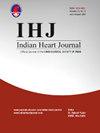Fragmented QRS complex as a predictor of in-hospital life-threatening arrhythmias in myocardial infarction patients: A systematic review and meta-analysis
IF 1.8
Q3 CARDIAC & CARDIOVASCULAR SYSTEMS
引用次数: 0
Abstract
Background
Ventricular arrhythmia is an important cause of death in myocardial infarction (MI). Fragmented QRS (fQRS) is an ECG pattern reflecting the inhomogeneity of ventricular conduction and has been demonstrated to be a predictor of arrhythmia in several cardiac conditions. This study aimed to evaluate the prognostic impact of fQRS on arrhythmias in MI patients.
Methods
A systematic search was conducted using 4 databases, including PubMed, Embase, Web of Science, and Cochrane CENTRAL, from inception to July 20, 2024. The inclusion criteria were studies that included MI patients and compared the rate of in-hospital arrhythmia between fQRS and non-fQRS participants.
Results
A total of 14 studies were included in this meta-analysis, involving 4566 participants. The presence of fQRS was associated with a higher incidence of ventricular tachycardia (VT) and ventricular fibrillation (VF) compared to non-fQRS, with an odds ratio (OR) of 2.96 (95 %CI 2.00 to 4.39), p < 0.01. Similarly, fQRS was associated with a higher risk of VT, with an OR of 3.59 (95 %CI 1.66 to 7.80), p < 0.01. Although the presence of fQRS did not significantly increase the risk of VF compared to non-fQRS, a sensitivity analysis that excluded a study with serious risk of bias showed that the presence of fQRS was associated with an increased risk of VF, with an OR of 2.45 (95 %CI 1.38 to 4.35), p < 0.01.
Conclusions
The presence of fQRS was associated with a higher risk of in-hospital arrhythmia in MI patients. The fQRS is a potential tool for risk stratification in MI patients for arrhythmia.
碎片化QRS复合体作为心梗患者院内危及生命的心律失常的预测因子:一项系统回顾和荟萃分析
背景:室性心律失常是心肌梗死(MI)死亡的重要原因。碎片化QRS (fQRS)是一种反映心室传导不均匀性的心电图模式,已被证明是几种心脏疾病心律失常的预测指标。本研究旨在评估fQRS对心肌梗死患者心律失常的预后影响。方法:系统检索PubMed、Embase、Web of Science、Cochrane CENTRAL 4个数据库,检索时间自成立至2024年7月20日。纳入标准是纳入心肌梗死患者的研究,并比较fQRS和非fQRS参与者之间的院内心律失常发生率。结果:本荟萃分析共纳入14项研究,涉及4566名受试者。与非fQRS相比,fQRS的存在与室性心动过速(VT)和心室颤动(VF)的发生率较高相关,优势比(OR)为2.96 (95% CI 2.00至4.39),p结论:fQRS的存在与MI患者院内心律失常的高风险相关。fQRS是心肌梗死患者心律失常风险分层的潜在工具。
本文章由计算机程序翻译,如有差异,请以英文原文为准。
求助全文
约1分钟内获得全文
求助全文
来源期刊

Indian heart journal
CARDIAC & CARDIOVASCULAR SYSTEMS-
CiteScore
2.60
自引率
6.70%
发文量
82
审稿时长
52 days
期刊介绍:
Indian Heart Journal (IHJ) is the official peer-reviewed open access journal of Cardiological Society of India and accepts articles for publication from across the globe. The journal aims to promote high quality research and serve as a platform for dissemination of scientific information in cardiology with particular focus on South Asia. The journal aims to publish cutting edge research in the field of clinical as well as non-clinical cardiology - including cardiovascular medicine and surgery. Some of the topics covered are Heart Failure, Coronary Artery Disease, Hypertension, Interventional Cardiology, Cardiac Surgery, Valvular Heart Disease, Pulmonary Hypertension and Infective Endocarditis. IHJ open access invites original research articles, research briefs, perspective, case reports, case vignette, cardiovascular images, cardiovascular graphics, research letters, correspondence, reader forum, and interesting photographs, for publication. IHJ open access also publishes theme-based special issues and abstracts of papers presented at the annual conference of the Cardiological Society of India.
 求助内容:
求助内容: 应助结果提醒方式:
应助结果提醒方式:


